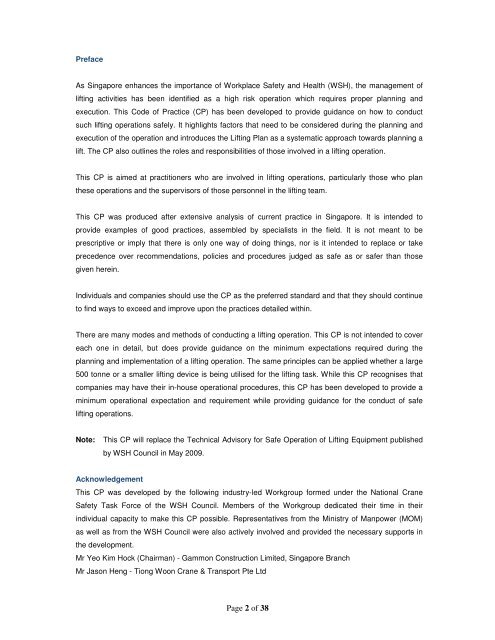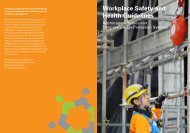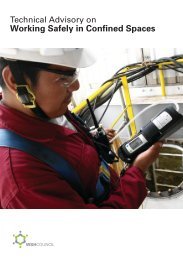Code of Practice - Workplace Safety and Health Council
Code of Practice - Workplace Safety and Health Council
Code of Practice - Workplace Safety and Health Council
You also want an ePaper? Increase the reach of your titles
YUMPU automatically turns print PDFs into web optimized ePapers that Google loves.
Preface<br />
As Singapore enhances the importance <strong>of</strong> <strong>Workplace</strong> <strong>Safety</strong> <strong>and</strong> <strong>Health</strong> (WSH), the management <strong>of</strong><br />
lifting activities has been identified as a high risk operation which requires proper planning <strong>and</strong><br />
execution. This <strong>Code</strong> <strong>of</strong> <strong>Practice</strong> (CP) has been developed to provide guidance on how to conduct<br />
such lifting operations safely. It highlights factors that need to be considered during the planning <strong>and</strong><br />
execution <strong>of</strong> the operation <strong>and</strong> introduces the Lifting Plan as a systematic approach towards planning a<br />
lift. The CP also outlines the roles <strong>and</strong> responsibilities <strong>of</strong> those involved in a lifting operation.<br />
This CP is aimed at practitioners who are involved in lifting operations, particularly those who plan<br />
these operations <strong>and</strong> the supervisors <strong>of</strong> those personnel in the lifting team.<br />
This CP was produced after extensive analysis <strong>of</strong> current practice in Singapore. It is intended to<br />
provide examples <strong>of</strong> good practices, assembled by specialists in the field. It is not meant to be<br />
prescriptive or imply that there is only one way <strong>of</strong> doing things, nor is it intended to replace or take<br />
precedence over recommendations, policies <strong>and</strong> procedures judged as safe as or safer than those<br />
given herein.<br />
Individuals <strong>and</strong> companies should use the CP as the preferred st<strong>and</strong>ard <strong>and</strong> that they should continue<br />
to find ways to exceed <strong>and</strong> improve upon the practices detailed within.<br />
There are many modes <strong>and</strong> methods <strong>of</strong> conducting a lifting operation. This CP is not intended to cover<br />
each one in detail, but does provide guidance on the minimum expectations required during the<br />
planning <strong>and</strong> implementation <strong>of</strong> a lifting operation. The same principles can be applied whether a large<br />
500 tonne or a smaller lifting device is being utilised for the lifting task. While this CP recognises that<br />
companies may have their in-house operational procedures, this CP has been developed to provide a<br />
minimum operational expectation <strong>and</strong> requirement while providing guidance for the conduct <strong>of</strong> safe<br />
lifting operations.<br />
Note: This CP will replace the Technical Advisory for Safe Operation <strong>of</strong> Lifting Equipment published<br />
by WSH <strong>Council</strong> in May 2009.<br />
Acknowledgement<br />
This CP was developed by the following industry-led Workgroup formed under the National Crane<br />
<strong>Safety</strong> Task Force <strong>of</strong> the WSH <strong>Council</strong>. Members <strong>of</strong> the Workgroup dedicated their time in their<br />
individual capacity to make this CP possible. Representatives from the Ministry <strong>of</strong> Manpower (MOM)<br />
as well as from the WSH <strong>Council</strong> were also actively involved <strong>and</strong> provided the necessary supports in<br />
the development.<br />
Mr Yeo Kim Hock (Chairman) - Gammon Construction Limited, Singapore Branch<br />
Mr Jason Heng - Tiong Woon Crane & Transport Pte Ltd<br />
Page 2 <strong>of</strong> 38

















